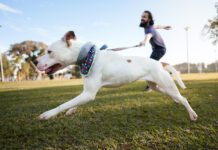When my beloved Border Collie, Rupert, was a puppy, I was pleased that he wasn’t one of those “sharky” pups who was forever putting his pin-sharp teeth through my skin. In fact, I was so grateful, I never ever stopped to wonder why he never tried to bite or chew on me, not even a tiny bit.
If we were playing or roughhousing, he’d occasionally grab a pant leg or sweatshirt sleeve in hopes of initiating an exhilarating game of tug, but if he accidently put his teeth on my wrist or ankle, he’d immediately let go and cower, as if worried he’d get hit. I certainly never hit him, and he was raised on a sheep ranch, where I figure the farming family members were probably rather too busy to take time away from 1,000 sheep and about 12 other dogs to abuse any individual puppy. I guessed that he simply was an incredibly sweet and submissive puppy, ever sensitive to causing another creature a bit of harm.
I was dead wrong.
I still have no idea how or where Rupert developed his extreme reluctance to put his teeth on me or anyone else. But what I learned later in Rupe’s life was that because he had never learned how to gently put his teeth on me or anyone else, when he was scared enough or backed into a corner, he would defend himself with a single, quick bite that punctured skin.
I didn’t get it until after I started editing this magazine, and had the opportunity to read a number of dog training books and attend lectures on dog training and behavior. By then, Rupert had bitten two people, about five years apart: the five-year-old daughter of a good friend, who had (unbeknownst to me or her mom) chased him into a room from which he could not escape and then tried to hug him, and a teenaged girl who leaned into the open back of my little station wagon, trying to pet him (despite the fact that he was cowering away from her). Both bites punctured the skin, and both bites were to the child’s face.
You can imagine; I could not have been more mortified.
I knew that in each instance he was frightened, but I could not understand why his bite was so hard in each instance – until I learned about “bite inhibition,” and what an important thing it is for dogs to learn. You can have the benefit of learning about it now, before you get your next puppy, I hope. See Training Editor Pat Miller’s article, “Bite-Me-Not,” in this issue.
While this may seem counter-intuitive to a dog owner who is highly concerned about creating a companion dog who is friendly and sociable, I think about it like this: If my darling but puncture-prone Rupert had growled at either one of the children before he bit them, I’m sure that both of them would have removed themselves from his vicinity – fast – and saved themselves a trip to the emergency room. Rupert never once growled at anyone in his lifetime, but that was clearly not a sign that he was okay with kids.
As I’ve said so many times in the past, I can’t wait for the opportunity to do things right with my next dog. Maybe you won’t have to wait so long.





